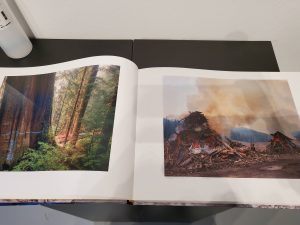By: Kelly Chia, Staff Writer
Stalkaya – Ḵ’elhmáy̓/X̱ápay̓ay is an exhibition based on the Skwxwu7mesh (Squamish) people’s relationship with cedar trees in old growth forests. The exhibit’s title refers to the traditional names for the Dakota Bear Sanctuary, yellow cedar, and red cedar, respectively.
Co-curated by T’uy’t’tanat (Cease Wyss), and featuring the works of fellow Indigenous artists Tsawaysia Spukwus and Sesemiya (Tracy Williams), Stalkaya – Ḵ’elhmáy̓/X̱ápay̓ay centres around the ways Skwxwu7mesh peoples have used cedar for time immemorial. It encourages love and respect for ancient forests which have protected our climate and wildlife.
When visitors first enter the exhibit, they are greeted with objects Skwxwu7mesh artists made with cedar such as clappers (a musical instrument), bailers (used to scoop out water from canoes), and clothing.
Williams’ work considers her use of cedar and the patterns she weaves, interspersing them with her reflections of home.
“This tunic and leggings were made for my son when he was six years old. Ten years later, and he is so much taller than me [ . . . ] that I look up to him. They are made from yellow cedar that was gathered from our homelands,” she says.
Spukwus’ work shows how every part of the cedar tree is used in diverse ways. One of their pieces is a bailer, made using red cedar. Spukwus also has clappers and hoops for display, which are used for music and dance.
Altogether, these displays pay homage to the importance of cedar trees to Skwxwu7mesh peoples and hold a unique sense of warmth.
To further showcase cedar’s significance, Wyss guides visitors through Stalkaya in SANCTUARY: The Dakota Bear Ancient Forest Experience, a film made by Wyss and collaborators Damien Gillis and Olivier Leroux.
In a promotional video about the exhibition and film, Wyss says Stalkaya is “a small sliver of what’s left of this ancient forest, and this ancient forest has been there since the Ice Age.” The video explains how the trees clean the carbon atmosphere, and provide homes for a variety of wildlife.
“To put it very bluntly, there is one-third of the natural world left on this planet. And a majority of that is through the Americas, and specifically here on the Pacific Northwest coast, we are so fortunate to have probably a third of that third,” Wyss says. “My hope is that through our community learning about Stalkaya [ . . . ] our people will be able to stand up and have a voice together and see how important it is that we allow this sliver of a forest to remain intact for centuries ahead.”
The film is a simply breathtaking experience. It is projected onto a dome, so viewers are immersed in a 360° view of Stalkaya as Wyss narrates. Watching SANCTUARY, one of the most memorable points is when Wyss brings the audience into a two thousand year-old trunk hollow, where black bears make their dens. The viewer takes in lichen, moss, and the massive roots of these magnificent trees where sunlight streams through.
That beauty is what makes the second part of the film all the more evocative: it cuts from a gorgeous overview of the ancient forest to the jarring sights and sounds of clear-cut logging operations. Instead of luscious trees, we see a mess of trunk limbs and machinery. We explore artificial forests built with trees that are unsustainable for wildlife.
Wyss explains the trees are short, weak, and too close to each other. They don’t let much sun into the forest grounds, and are crowded compared to the ancient forests in the first part of the film. As she guides us back to Stalkaya, Wyss emphasizes the history of these forests — which have stood for millennia — and the necessity of protecting them for future generations.

While BC recently signed an agreement with the Skwxwu7mesh peoples to protect Stalkaya, Wyss says we need to continue supporting efforts to conserve these forests.
Wyss hopes bringing awareness to Stalkaya will motivate people to protect other old growth forests like it. Sierra Club BC, an organization dedicated to supporting abundant ecosystems, says that there are “only about 400,000 hectares of old-growth forests with big old trees remaining across all of B.C.”
One way to protect BC’s ancient growth forests is to call your MLA and pressure them to commit to defer logging at-risk ancient growth forests. Sierra Club BC has listed a few talking points for these calls on their website. They also encourage writing to forests minister Katrine Conroy, and asking her to fund the 14 recommendations made by the Old Growth Strategic Review Panel. The panel’s report lays out ways to work with Indigenous governments to protect these forests within three years. Though Premier John Horgan promised to implement these recommendations over a year ago, there have been little changes.
As a result, more of BC’s old growth forests — like Fairy Creek Watershed — are endangered. Environmental activists have gathered at Fairy Creek for over a year now. A list of action items has been created to help support the Fairy Creek Blockade, which include emailing the RCMP Public Safety Minister, Mike Farnworth, at [email protected] about the RCMP’s conduct, especially as BIPOC protestors are targeted at the frontlines of this blockade. This online fundraiser provides general and legal expenses for communications and personal support for marginalized land defenders.
Most importantly, in conversations about protecting ancient forests, it is important that Indigenous sovereignty remains at the forefront. Indigenous peoples are the stewards of these forests, and supporters’ role is to stand in solidarity with them as they defend their land. Help fund Indigenous governance authority by supporting the Nuchatlaht, a nation taking the BC government to court on their title to reclaim their role as stewards of their land and waters.
SANCTUARY: The Dakota Bear Ancient Forest Experience is playing at the Museum of Anthropology (MOA) on Fridays and Saturdays until September 26. For more information, visit MOA’s website.







